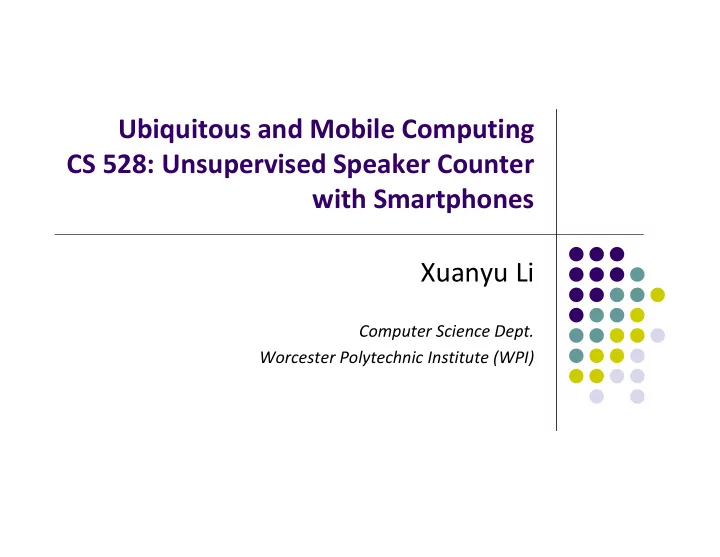

Ubiquitous and Mobile Computing CS 528: Unsupervised Speaker Counter with Smartphones Xuanyu Li Computer Science Dept. Worcester Polytechnic Institute (WPI)
Introduction Conversation is very important ! Most direct form of social interactions Relevant researches Speaker Identification Characterization of social settings BUT what might be overlooked ???
Introduction Speak counter: measurement of number of people in a conversation App name: crowd++ Motivation? Social hotspot Social diary LAST BUT NOT LEAST ? Participation Estimation (class participation)
Challenges Location (pocket or bag) hardware constraints noise polluting
System Design First step: Speech detection Target: filter out silence periods and background noise Divide speech into segments (3s/segment) 3s? Provides good trade ‐ off between inference delay and accuracy Tradition: energy ‐ based voice data detection (unsuitable for mobile device) Crowd++: Pitch
System Design Second step: Feature Extraction Precondition: filtered out non ‐ speech/background noise Postcondition: extracted features can effectively distinguish speakers The Less overlap, the better
System Design Counting Engines Counting algorithm Traditional: hierarchical clustering Compares each segment with the other, thus runs in O(n^2) time ( {S1, S2, S3, …… , Sn} ) Crowd++: forward clustering Compares adjacent segments and merge the similar ones, runs in O(n) time ( {((S1, S2), S3), S4 ……, Sn} )
System Design If (S1 close to S2) { merge(S1, S2) to S1; compare S1 with S3; } else compare S2 with S3; …… do above recursively until traverse is done
Evaluation Performance metrics: Name : Error Count Distance Definition: |C^ – C| C^: estimated number by the app C: real number of participants Energy consumptions Cycling: 5min recording + algorithm + sleep(T interval) Lower bound performance (battery) Mainly used in public location
Performance with a single group 1. Phone 0-3 on the table 2. Phone 4-6 in users pocket Conclusion: If on table, position does not matters much In pocket is not as accurate as on table
Performance with multiple groups For instance: Restaurant Something quite interesting is that …… Possible explanation: Pocket phone has better ability to filter out distant sound
Performance with various conversation parameters Audio Clip Duration (longer, better) Overlapping Percentage (No noticeable influence found) Utterance Length (0 ‐ 3s fluctuate, >3s stable with error distance decreased to 1)
Privacy Concerns Speaker’s identification is never revealed (extra algorithms) Data analysis is always performed locally in case of data leakage User has the option when to activate the application
Conclusion Unsupervised (no prior models, external hardware) No machine learning algorithms Totally local on device Great accuracy with low error distance Multiplatform support
References
Thank you !
Recommend
More recommend